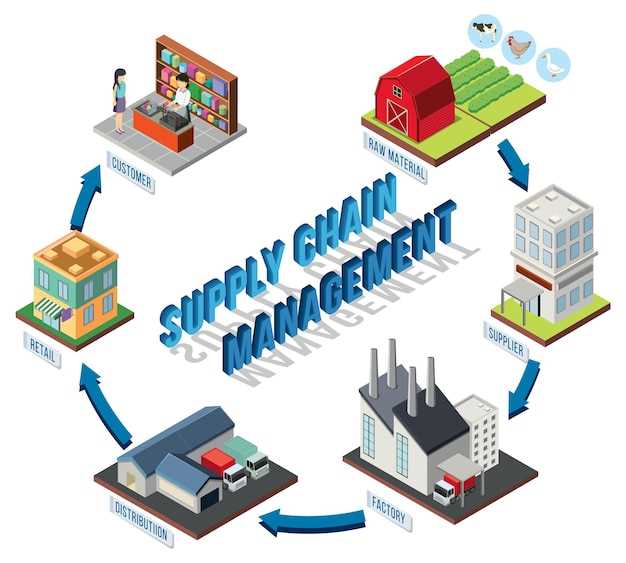Map your entire supplier network and deploy a real-time risk dashboard now. This business-level move aligns demand with available capacity and protects essential lines, including food supply, from sudden shocks. By assigning clear account for suppliers and sharing data across your network, you know where disruptions originate and who must respond. hajmohammad notes that action beats analysis when pressure mounts.
Adopt blockchain-based traceability to lock in the facts that matter. A distributed ledger with consensus among participants reduces data drift and strengthens both supplier accountability and consumer trust. Link the ledger to procurement, inventory, and software that tracks shipments, temperatures, and delivery windows. This approach creates a clear leader role for your organization and yields tangible opportunities to cut waste and improve service.
Extreme events, including weather shocks, port delays, and rapid demand shifts, expose gaps in planning. Build redundancy by multi-sourcing, nearshoring where feasible, and safety stock for critical items like staple inputs. Use scenario testing to quantify risk exposure and set thresholds for triggering supplier diversification.
To turn data into action, foster a cross-functional organization that includes procurement, operations, finance, and sustainability. A leader sets measurable targets, while a shared network of suppliers and customers uses standardized data formats to know status in real time and so you can address issues with them promptly.
Data-driven monitoring improves resilience. In surveys, 60–70% of firms report supplier risk and delivery delays in the past year, and those with integrated systems cut inbound disruptions by a sizable margin. Track key metrics such as on-time in full (OTIF), order cycle time, and waste rates for food products. Linking ESG goals to supplier performance boosts long-term value for business and customers alike.
Start with a phased plan: pilot with a critical supplier, deploy blockchain-enabled tracing for top five SKUs, then scale across categories. Use software integrations with ERP and WMS to capture data feeds automatically. Regular consensus checks across the supplier network ensure data integrity and reduce disputes. The result is reduced disruptions, stronger customer trust, and new business opportunities in sustainability reporting.
StrategicRISK: Sustainability in Supply Chains – Practical Insights
Begin with a 90-day supplier risk check and diversify procurement for critical product lines to curb disruptions. An assistant will input data into a centralized system to know which vendors pose time risks and introduce environmental criteria and waste-reduction goals in contracts. Define performance through measurable SLAs and supplier scorecards, and assign a clear role and time-bound accountability. Use them to align needs with insurers and business partners, and communicate through contracts. Leverage example cases from media and journal, and draw on professor insights to sharpen selection criteria. Prepare a reporting frame for environmental and waste metrics, and share with suppliers to secure commitments.
| Area | Current State | Mitigation | Owner | Time to Implement | KPI |
|---|---|---|---|---|---|
| Disruptions from supplier failure | Delivery deltas 12% over last quarter | Diversify sources across four regions; maintain 60-day safety stock; formal transition plans | Procurement Lead | 8 weeks | On-time deliveries 98% |
| Lead-time variability | Average lead time 21 days; 25% variance | Standardized onboarding; multi-regional sourcing; 2-week rolling orders | Supply Chain Manager | 6 weeks | Lead time variance < 5% |
| Environmental compliance risk | 15% suppliers fail audits | Quarterly audits; environmental scorecards; supplier improvement plans | Environmental Lead | 12 weeks | Audit pass rate 95% |
| Packaging waste footprint | Packaging waste 0.6 kg per unit | Switch to recyclable packaging; reduce packaging by 20%; track waste per unit | Operations Manager | 10 weeks | Waste per unit 0.5 kg |
Sustainability in Supply Chains: The Growing Issue of Disruption and Actionable Guidance for SMEs and the Business Community
Begin with a rapid risk mapping of term suppliers and operations, and set a 90-day action plan to diversify sources. Identify the most critical components, assign owners, and ensure the plan aligns with your company’s growth goals and capacity to manage changes.
Monitor trends across europe and worldwide, and track headlines that signal potential chokepoints in transport, manufacturing, and finished-goods delivery. Use these signals to adjust sourcing and inventory policies before disruptions cascade through the value chain.
Adopt technology-enabled platforms to improve transparency: create an exchange of data with suppliers and buyers, standardize metrics, and maintain an up-to-date account of risk exposure. A coordinated data view eases operating decisions and shortens response times when events occur in complex networks.
Strengthen operating resilience through multi-sourcing critical items, review contracts to include resilience clauses, and keep enough buffer stock for instance products with high demand volatility. This approach yields a clearer result and reduces the total level of exposure across the supply base.
Manage demand and capacity by mapping demand signals, aligning orders with production reality, and coordinating with public and industry bodies. This helps you tamp down excessive orders during spikes and avoids waste across the value chain, especially for small firms seeking steady growth.
Address water and climate threats by evaluating supplier locations, investing in water-use efficiency, and encouraging disclosure of water-risk data. Include site-level risk reviews in supplier scorecards to reveal gaps before they become costly interruptions.
Engage insurers and finance partners early to cover interruption risk, and consider public-backed guarantees for critical routes. A proactive financial approach lowers the barrier to action for SMEs and supports long-term resilience in the supply network.
Measure progress with concrete indicators: total cost of disruption avoided, changes in lead times, supplier diversification, and the number of controls implemented. Track results quarterly and link them to the needed capital expenditure and management capability to deliver sustained growth for the entire company.
For the business community, start with a small pilot in a focused product line, document the outcome, and scale based on demonstrated value. Assign an owner, capture learnings, and communicate early to buyers and insurers to build momentum and public trust, while ensuring enough momentum to drive broader changes across the industry.
Map Supplier Disruption Risk with Real-Time Monitoring
Start by implementing a real-time risk map using a centralized data hub that streams status from suppliers, logistics partners, and carriers. Define a 3-layer risk schema–operational, financial, and geospatial–and set alert thresholds at 30% downtime, 48 hours of delay, or a port closure. Assign clear ownership to the right teams and publish a daily digest for leaders.
Defining these thresholds with managers ensures timely action and reduces noise during extreme disruptions. Build a single view that combines internal signals with external feeds so decisions rest on a total, up-to-date picture.
Pull data from ERP, WMS, TMS, supplier portals, weather feeds, customs and port data, and geopolitical signals. Use APIs and streaming queues to feed a dashboard that shows disruptions by tier and geography. Map where risk concentrates, including arctic routes and alternate corridors. Track total exposure by supplier and product family to reveal where concentration risk lies.
Adopt a risk scoring framework: probability, impact, and detectability; calibrate with historical disruptions and external signals. Use both qualitative and quantitative data to classify suppliers into high, medium, and low risk. Build massively scalable visualizations to show how disruptions propagate across tiers and products.
With blockchain, maintain immutable audit trails and streamline cross-team consensus. As hajmohammad notes, blockchain-backed ledgers improve visibility across the network, which helps insurers and risk managers coordinate responses. Use smart alerts to trigger containment actions and notify stakeholders automatically.
Decision framework and governance must include a formal escalation matrix, defined decision rights, and regular exercises. This reduces time-to-decision during disruptions. Efforts should target reducing disruptions with proactive supplier diversification and near real-time renegotiation options. Managers should review where disruptions originate and adjust sourcing strategies accordingly, with total transparency for finance and procurement teams. Have a consensus-based process that includes insurers where relevant and consider how to engage multiple stakeholders across companys.
- Data sources and integration points for real-time visibility
- Risk scoring rules and threshold settings
- Alerting, escalation, and decision rights
- Contingency options, including alternate suppliers and routes
- Performance metrics and continuous improvement loops
Engage SMEs in Circular and Collaborative Supply Models

Recommendation: Launch a targeted pilot with 6-8 SMEs that share similar input streams and end-markets, anchored by a lightweight exchange platform to move surplus materials and services between these companies, with each company contributing a modest initial stock.
sheri from the regional chamber coordinates the first exchange workshop to set the rules, establish common data standards, and unlock the exchange of ideas. These sessions focus on identifying circular use-cases, mapping material flows, and defining a shared governance for the collective.
Define KPIs and track progress: material recovery rate, value captured per cycle, average time from surplus to reuse, and the ratio of revenue saved versus transaction costs. Target material recovery above 60% within the pilot, with 12–20% net savings across participating companies. These metrics reveal opportunities and clearly show the trade-offs to managers and insurers.
Engage insurers early to model risk-sharing contracts and to price the insurable value of circular portfolios, including second-life assets and service contracts. This reduces extreme risk and helps finance teams optimize working capital across the network.
Build a concise school module for SME leaders that covers circular design thinking, collaboration protocols, and practical steps to run a material exchange. Use these ideas to turn needs into action, helping leaders think differently and focus on sustainable outcomes.
Structured process steps include mapping needs and assets, identifying partners and data standards, running a 90-day exchange trial, capturing lessons, and quantifying gains. This approach minimizes friction and accelerates onboarding of additional participants across sectors.
These models shift power across industries toward the collective of small players, unlocking scalable, sustainable pathways that reduce resilience gaps in supply chains and transform how we view risk and opportunity.
Implement Sustainable Procurement: Quick Wins and Practical Pitfalls

Begin with a spend map and a 6-month target to shift 20% of total supplier spend to verified sustainable sources. This concrete move creates immediate momentum and sets clear accountability for buyers across the organization.
Recent research into sustainable procurement by hajmohammad, a professor and activist, into the field shows that embedding sustainability into sourcing reduces threats; risks rise when data is siloed, while cross-functional management lowers those risks. Going forward, think in terms of total price and long-term value, not just upfront price. This approach provides measurable value for operations and helps organization-wide resilience.
- Create a simple supplier sustainability scorecard with 5 metrics: price, emissions, labor practices, delivery reliability, and total cost of ownership; use it in all RFPs and every contract, including product origin tracing.
- Consolidate vendors to raise power in negotiations; establish 2-3 year contracts with performance triggers that protect price stability while rewarding responsible outcomes.
- Embed sustainability criteria into RFPs; tie a portion of incentive payments to meeting social and environmental metrics provided by the supplier.
- Run a pilot across two to three regions to measure impact on operations and risk; use the results to scale quickly.
- Invest in supplier development programs that are helping small firms grow, reducing poverty and improving resilience across communities while ensuring product quality.
- Build a transparent price framework that shows total price, including transport, packaging, and end-of-life costs; this helps buyers compare options fairly.
- Establish a cross-functional governance group to manage supplier risk and ensure compliance; assign owners across procurement, sustainability, and operations.
- Track supplier performance using a simple dashboard; report monthly to leadership to sustain momentum.
Practical pitfalls:
- Focusing solely on price without considering total price and long-term value; price may look good, but hidden costs rise with poor durability or logistics.
- Creating heavy audit requirements that slow operations and deter supplier participation.
- Assuming all suppliers can meet ambitious targets without proper support or capacity-building; need a staged approach.
- Neglecting data sharing across departments, causing gaps in supplier risk visibility and performance tracking.
- Relying on a single region for supplier data, missing threats in geographies with weak regulation.
- Underestimating the time needed to implement a new governance framework across the organization.
- Skipping exit plans or single-sourcing that blocks supply chain resilience when a supplier fails.
Leverage Technology for Traceability and Data-Driven Decisions
Implement a real-time traceability platform that links suppliers, manufacturers, carriers, insurers, and customers to capture every event around shipments and production milestones. Define the data points to collect, defining ownership and automation rules, and automate alerts when a deviation occurs, so teams are never unable to act. This creates an auditable trail that supports risk management and operational resilience.
Through standards-based data exchange (GS1, EDI, API) you create consistency across the supply network, aligning with a consensus of status and reducing miscommunication around delays such as port bottlenecks or quality events. Such clarity helps the organization move faster and improve collaboration around critical decisions, from sourcing to delivery.
McKinsey studies indicate that firms with end-to-end traceability can increase efficiency and reduce disruption costs by enabling rapid detours and contract adaptation. Track these metrics with dashboards that surface costs, price movements, and supplier performance. These insights drive actions such as alternative sourcing and, vice versa, smarter routing and exchange to optimize results.
Data science moves from reporting to forecasting: analyze drivers of disruption–supplier risk, transit delays, quality events, and price shocks–and translate findings into concrete actions: dynamic safety stock, diversified sourcing, and terms aligned with risk exposure. Such analyses prime the organization for proactive responses that strengthen the world’s supply networks.
Organize governance as a living framework: define master data, assign data owners in the organization, maintain a single source of truth, and create a data dictionary. Creating a data maturity plan primarily focused on data quality, access controls, and audit trails helps insurers and suppliers rely on the same numbers, reducing conflicts and accelerating claims processing.
Implementation checklist: map critical suppliers and products; enable exchange with providers, carriers, and insurers; deploy IoT sensors, RFID tags, and product authentication to capture events and create data around shipments; set rule-based alerts for thresholds; train teams and embed governance into daily workflows. This move yields measurable results through standardized processes and collaboration across the world.
Drive Industry-Wide Sustainability Across the Supply Chain
Implement a universal supplier sustainability scorecard and a cross-company data exchange platform within 180 days that standardizes metrics across tier-one to tier-three suppliers and anchors decisions in auditable data. The system should track emissions, water use, waste, labor standards, and ethical sourcing, and tie performance to procurement decisions and contract renewals.
Set up actions to diversify sourcing: create an alternative supplier map, maintain two to three approved producers per critical resource, including food items, and establish minimum stock buffers to mitigate disruptions. Use tehnologie to monitor supplier health signals such as on-time delivery, capacity constraints, and share alerts across the network via the exchange.
Foster collaboration peste companies and sectors for a collective response. Create joint improvement programs, share best practices, and align on a common term for supplier development. The goal is to build a future where risk is detected early, and suppliers are engaged in a supportive, win-win path toward sustainability.
Utilizare date science to map risk hotspots, quantify impacts on operations, and guide actions pentru mitigate potential losses. Track resource efficiency, energy intensity, and labor conditions, especially in food chains, to ensure ocuparea forței de muncă protection and stable working conditions. This reduces disruptions and supports long-term planning beyond quarterly cycles. By embedding scenario planning, managers can determine what is possible when a supply shock occurs and to move quickly to alternative suppliers while keeping costs in check.
Many suppliers dont have mature data systems; provide onboarding support and phased data collection to avoid overburdening small partners. Mandate concise, annual public reporting on a core set of KPIs and align incentives with collective progress to maintain momentum and trust across the network.

 Sustainability – The Growing Issue of Supply Chain Disruption">
Sustainability – The Growing Issue of Supply Chain Disruption">
